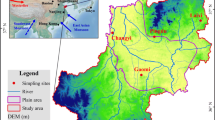Abstract
The stable isotopic contents of precipitation and deuterium excess (d-excess) data justified the hypothesis that two distinct vapor sources are responsible for precipitation at Tarbela. Summer vapor source from Bay of Bengal/Arabian Sea is characterized by low d-excess (≤ 10) and enriched isotopic values are due to high evaporation rate at source. δ18O and δ2H approaches 1 and 14‰ respectively in summer with d-excess 6‰.Winter vapor source is from Mediterranean Sea. Depleted isotopic values due to low evaporation rate at source are characterized by high d-excess values (≥ 16‰). δ18O and δ2H approaches − 9.8 and − 62‰ respectively with d-excess 17‰.






Similar content being viewed by others
References
Ian D, Clark, Fritz P (1997) Environmental isotopes in hydrogeology
Liu J, Song X, Fu G, Liu X, Zhang Y, Hand D (2011) Precipitation Isotope characteristics and climatic controls at a continental and an island site in Northeast Asia. Clim Res 49:29–44
Merlivat L, Jouzel J (1979) Global climatic interpretation of the deuterium-oxygen 18 relationship for precipitation. J Geophys Res 84:5029–5033
Hren MT, Bookhagen B, Blisniuk PM, Booth AL, Chamberlain CP (2009) δ18O and δ2D of stream waters across the Himalaya and Tibetan Plateau: implications for moisture sources and paleoelevation reconstructions. Earth Planet Sci Lett 288:20–32
Simin Qu ID, Chen X, Wang Y, Shi P, Shan S, Gou J, Jiang P (2018) Isotopic characteristics of precipitation and origin of moisture sources in Hemuqiao catchment, a small watershed in the lower reach of Yangtze river. Water 10:1170
Gat JR (2010) Series on environmental science & management. Vol-6, Isotope Hydrology, a study of water cycle
Jeelani G, Deshpande RD, Galkowski M, Rozanski K (2018) Isotopic composition of daily precipitation along the southern foothills of the Himalayas: impact of marine and continental sources of atmospheric moisture. Atmos Chem Phys 18:8789–8805
Aragu`as-Aragu`as L, Froehlich K, Rozanski K (2000) Deuterium and oxygen-18 isotope composition of precipitation and atmospheric moisture. Hydrol Process 14(8):1341–1355
Rozanski K, Araguas-Araguas L, Gonfiantini R (1993) Climate change in continental isotopic records. American Geophysical Union, Washington DC, pp 1–36
Kendall C, Coplen TB (2001) Distribution of oxygen-18 and deuterium in river waters across the United States. Hydrol Process 151:363–1393
Pfahl S, Sodemann H (2014) What controls deuterium excess in global precipitation. Clim Past 10:771–781
Juhlke TR, Meier C, van Geldern R, Vanselow KA, Wernicke J, Baidulloeva J, Barth JAC, Weise SM (2019) Assessing moisture sources of precipitation in the Western Pamir Mountains (Tajikistan, Central Asia) using deuterium excess. Tellus B 71:1601987
Kostrova SS, Meyer H, Fernandoy F, Werner M, Tarasov PE (2020) Moisture origin and stable isotope characteristics of precipitation in southeast Siberia. Hydrol Process 34:51–67
Dhar ON, Kulkarni AK, Sangam EB (1984) Some aspects of winter & monsoon rainfall distribution over the Garhwal-Kumaon Himalaya: a brief appraisal. Himal Res Dev 2:10–19
Dimri AP, Mohanty UC, Mandal M (2004) Simulation of heavy precipitation associated with an intense western disturbance over western Himalayas. Nat Hazards 31:499–521
Gadgil S (2003) The Indian monsoon and its variability. Ann Rev Earth Planet Sci 31:429–467
Safdar F, Khokhar MF, Arshad M, Adil IH (2019) Climate change indicators and spatiotemporal shift in monsoon patterns in Pakistan. Adv Meteorol. https://doi.org/10.1155/2019/8281201
Rao Y P (1976) Southwest monsoon; Meteorol Monogr Synoptic Meteorol 1/1976, India Meteorological Department, Delhi, India
Rasul G (2012) Climate data modelling and analysis of the Indus ecoregion. World Wide Fund for Nature – Pakistan
Craig J (1961) b Isotopic variation in meteoric waters. Science 133:1702–1703
Dansgaard W (1964) Stable isotopes in precipitation. Tellus 16:436–468
Butt S, Mahmood A, Rasul G et al (2013) Use of environmental isotopes to study the effect of climate change on Passu glacier. Sci Tech and Dev 32(1):74–83
WAPDA (2003). Power System Statistics 14th issue October Lahore 10–35
Craig H, Gordon LI (1965) Deuterium and oxygen 18 variations in the ocean and marine atmosphere. In proc. Stable Isotopes in Oceanographic Studies and Paleo temperatures, Spoleto, Italy. Edited by E Tongiogi 9–130, V Lishi e F Pisa
Rahul P, Ghosh P, Bhattacharya SK (2016) Rainouts over the Arabian Sea and Western Ghats during moisture advection and recycling explain the isotopic composition of Bangalore summer rains. J Geophys Res Atmos 121:6148–6163
Map Credit: UNEP Environment Assessment Programme for Asia and the Pacific (http://www.rrcap.unep.org)
Gat JR, Klein B, Kushnir Y et al (2003) Isotope composition of air moisture over the Mediterranean Sea: an index of the air-sea interaction pattern. Tellus B 55(5):953–965
Aggarwal PK (2002) Isotope hydrology at the International atomic energy agency. Hydrol Process 16(11):2257–2259
Gat JR, Bowser CJ, Kendall C (1994) The contribution of evaporation from the Great Lakes to the continental atmosphere: estimate based on stable isotope data. Geophys Res Lett 21(7):557–560
Acknowledgements
The present investigation was carried out within the framework of National project PINST 116. Sincere thanks are due to Dr. Azam Tasneem and Mr. Zahid Latif. Ex. Heads Isotope Application Division for the guidance/suggestions provided during the technical discussions and for facilitating this study. The co-operation of WAPDA at Tarbela, PCRWR and Meteorological Department for collection of samples and provision of data is highly appreciated. Efforts of the colleagues at Isotope Application Division, PINSTECH for analysis of samples are thankfully acknowledged.
Author information
Authors and Affiliations
Corresponding author
Additional information
Publisher's Note
Springer Nature remains neutral with regard to jurisdictional claims in published maps and institutional affiliations.
Rights and permissions
About this article
Cite this article
Malik, F., Butt, S. & Mujahid, N. Variation in isotopic composition of precipitation with identification of vapor source using deuterium excess as tool. J Radioanal Nucl Chem 331, 683–690 (2022). https://doi.org/10.1007/s10967-021-08136-6
Received:
Accepted:
Published:
Issue Date:
DOI: https://doi.org/10.1007/s10967-021-08136-6




